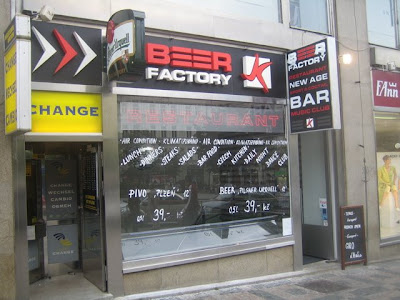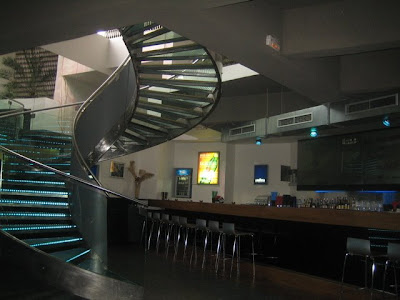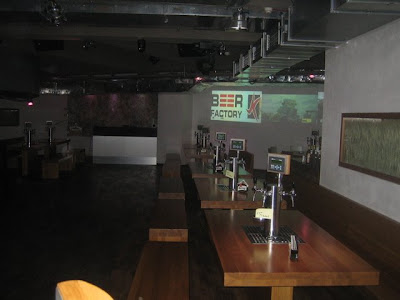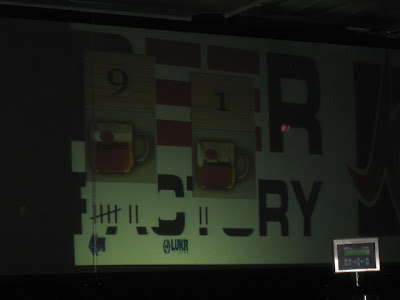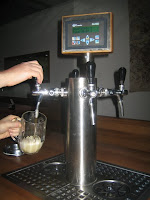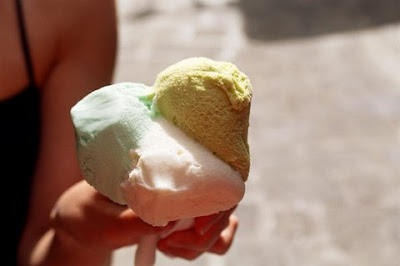In the same week, I got two recommendations to try Restaurace Mlýn (The Mill Restaurant). I looked at the menu online, and I liked what I saw.
It specializes in seafood and Mediterranean cuisine, which are big favorites for us. It is reasonably expensive, but the prices are not as high as many other top seafood places these days.
So, the next week, when another couple invited us to dinner and, by chance, offered Restaurace Mlýn as an option, I was quick to agree on it, even though it is quite a long trip to Prague 6 from where we live in Prague 10.
We took the metro out to Dejvice, and the tram up Evropska. Our friends offered to drive us all down from their place in Hanspaulka in Prague 6.
A very helpful reader says that it is possible to get there by public transport (see the comments section).
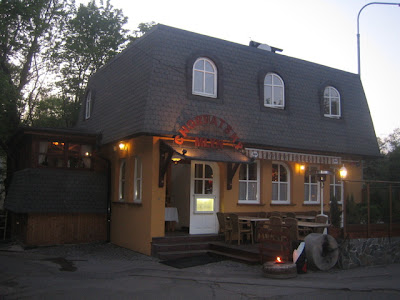 The sign out front actually says Chorvatsky Mlýn (The Croatian Mill), though the website only says Restaurace Mlýn. The dining room has a somewhat rustic interior. It was fairly empty when we were there about a month ago. I was told that Mlýn is something of a favorite with embassy types and business people. We did see a couple of Japanese tourists there. I've been told it is nice to eat outside there in the summer.
The sign out front actually says Chorvatsky Mlýn (The Croatian Mill), though the website only says Restaurace Mlýn. The dining room has a somewhat rustic interior. It was fairly empty when we were there about a month ago. I was told that Mlýn is something of a favorite with embassy types and business people. We did see a couple of Japanese tourists there. I've been told it is nice to eat outside there in the summer. I have to admit that since we ate at the restaurant quite a while ago, I don't have very detailed memories of the food. What I do have is pictures of almost everything.
I have to admit that since we ate at the restaurant quite a while ago, I don't have very detailed memories of the food. What I do have is pictures of almost everything.
For starters, Mr. UK recommended the Croatian prosciutto (Pršut) for 140 CZK (the website says it is 130 CZK). It was thicker cut than Italian-style prosciutto, but it was very tender, with a strong smoke flavor.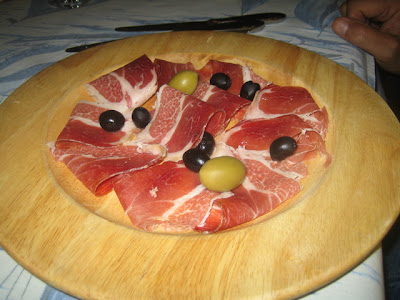 I had the beef carpaccio for 150 CZK -- A fairly basic version with good quality sliced beef, ruccola, shaved Parmesan, lemon wedges, and fresh cracked pepper.
I had the beef carpaccio for 150 CZK -- A fairly basic version with good quality sliced beef, ruccola, shaved Parmesan, lemon wedges, and fresh cracked pepper.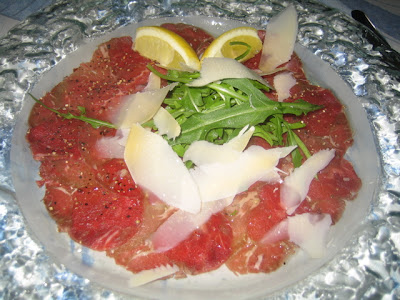 V ordered something she'd never tried before: Monkfish carpaccio (Carpacio z Mořského ďasu) for 160 CZK. It comes with lemon wedges, garlic, and olive oil.
V ordered something she'd never tried before: Monkfish carpaccio (Carpacio z Mořského ďasu) for 160 CZK. It comes with lemon wedges, garlic, and olive oil.
She loved it. I really liked it, too. Monkfish has a texture often compared to lobster. I thought it had a nutty flavor.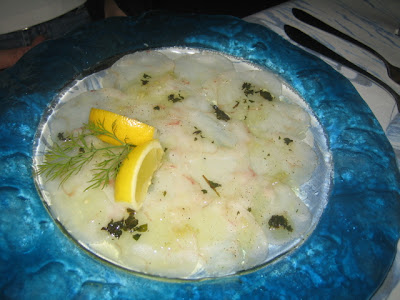 Let's run through the main courses. Jersey Girl had the grilled sea bass (Mořský vlk) for 507 CZK. She liked it.
Let's run through the main courses. Jersey Girl had the grilled sea bass (Mořský vlk) for 507 CZK. She liked it. The seafood is priced by weight. They use a somewhat complicated formula that, I think, requires a calculator. They start with a base price for either 100 or 200 grams. Then, for each 10 grams over the base, they add a specified amount of money.
The seafood is priced by weight. They use a somewhat complicated formula that, I think, requires a calculator. They start with a base price for either 100 or 200 grams. Then, for each 10 grams over the base, they add a specified amount of money.
So, be aware, seafood can significantly add to your bill.
Back to the food. There was grilled calamari (Kalamáry na grilu) for 320 CZK. Simple but delicious.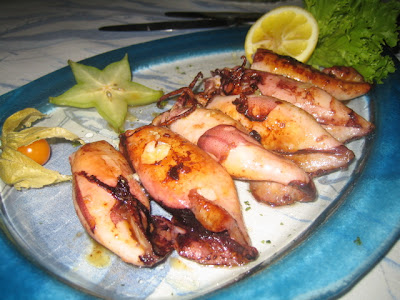 I had the risotto frutti di mare for 350 CZK. It was studded with tiger shrimp, grilled calamari, and mussels. I liked it, but my favorite version is still the one at Kogo in Slovanský dům.
I had the risotto frutti di mare for 350 CZK. It was studded with tiger shrimp, grilled calamari, and mussels. I liked it, but my favorite version is still the one at Kogo in Slovanský dům.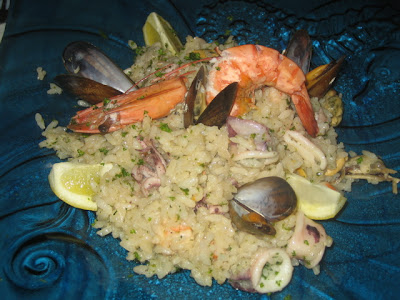 V had the grilled octopus (Chobotnice "Pod pekou") with potatoes and vegetables for 420 CZK. This is one of her favorites and she really enjoyed it.
V had the grilled octopus (Chobotnice "Pod pekou") with potatoes and vegetables for 420 CZK. This is one of her favorites and she really enjoyed it.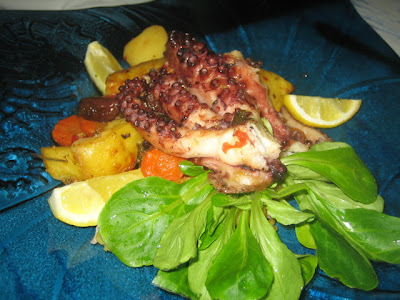 We shared two bottles of Vranac from the Plantaže winery in Montenegro (480 CZK each). Mr. UK recommended it, and said he'd ordered it before. It was very good.
We shared two bottles of Vranac from the Plantaže winery in Montenegro (480 CZK each). Mr. UK recommended it, and said he'd ordered it before. It was very good.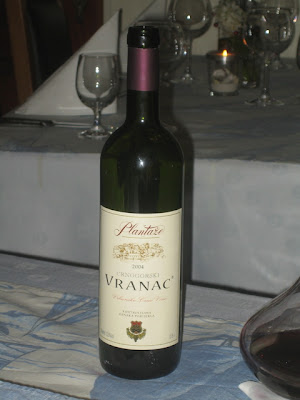 We had quite a few other things, including half liters of Pilsner Urquell for 45 CZK, a mixed salad for 60 CZK, "American" potatoes (Americké brambory) for 40 CZK, espresso for 35 CZK, and cafe latte for 55 CZK.
We had quite a few other things, including half liters of Pilsner Urquell for 45 CZK, a mixed salad for 60 CZK, "American" potatoes (Americké brambory) for 40 CZK, espresso for 35 CZK, and cafe latte for 55 CZK.
The total bill for the four of us was 3524 CZK.
I won't make Restaurace Mlýn a regular habit, partly because a good meal here is not cheap, but mostly because it is far from the center, and even farther from my home.
But if someone suggests it again for a special night out, I certainly won't mind making the trek.
Restaurant Mlýn
Horoměřická 3a
Prague 6
Tel: (+420) 220 610 760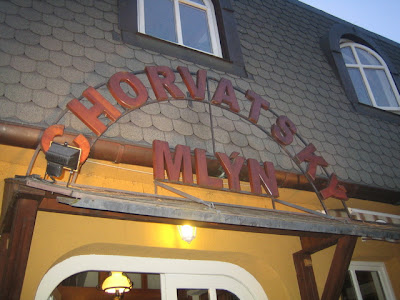
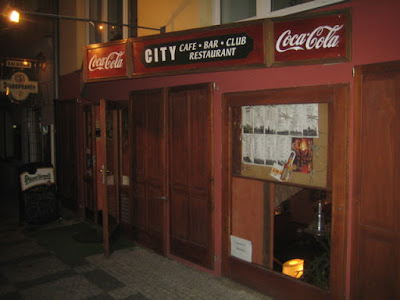 What drew us down the stairs was the nicely done interior, with exposed brick and good lighting. It's a nice space.
What drew us down the stairs was the nicely done interior, with exposed brick and good lighting. It's a nice space.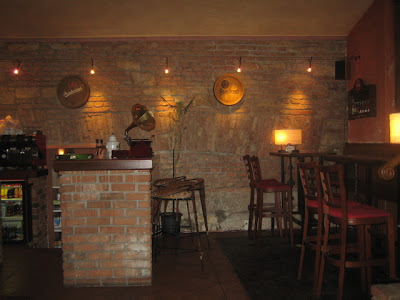 The menu didn't thrill me -- It had mostly Czech dishes and pasta. I wasn't in the mood. One offering was a little different -- pljeskavica -- the Balkan specialty that looks like a hamburger without a bun and is usually a mixture of ground lamb and beef and onions. The pljeskavica (99 CZK) was very greasy. Didn't love it.
The menu didn't thrill me -- It had mostly Czech dishes and pasta. I wasn't in the mood. One offering was a little different -- pljeskavica -- the Balkan specialty that looks like a hamburger without a bun and is usually a mixture of ground lamb and beef and onions. The pljeskavica (99 CZK) was very greasy. Didn't love it.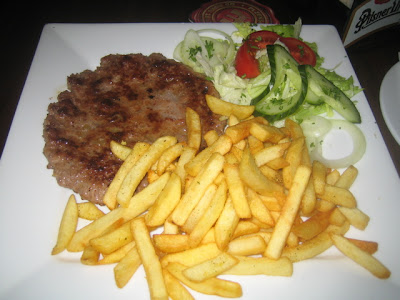 It didn't come with bread on the side, so I ordered fries (29 CZK). They were OK. I asked for ketchup and the waiter brought me a giant bowl. It did cost 20 CZK, though.
It didn't come with bread on the side, so I ordered fries (29 CZK). They were OK. I asked for ketchup and the waiter brought me a giant bowl. It did cost 20 CZK, though.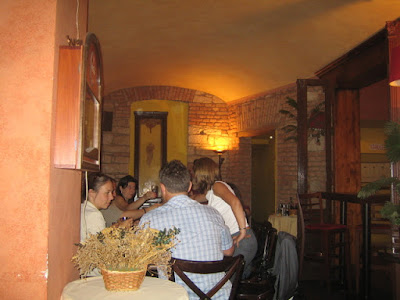 I wouldn't say you should go out of your way to City Cafe Bar Club. But in a part of town where it is sometimes hard to find a free seat in a bar, it's not a bad place to stop for a drink.
I wouldn't say you should go out of your way to City Cafe Bar Club. But in a part of town where it is sometimes hard to find a free seat in a bar, it's not a bad place to stop for a drink. *The accuracy of the attribution of this Paris Hilton quote is in dispute. However, Ms. Hilton has also been quoted as saying, “I don't really think, I just walk.”
*The accuracy of the attribution of this Paris Hilton quote is in dispute. However, Ms. Hilton has also been quoted as saying, “I don't really think, I just walk.”
